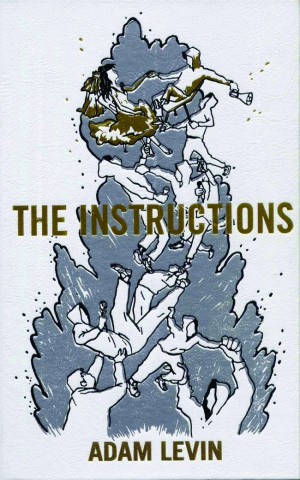Verbosity is like the Iniquity of Idolatry
Adam Levin’s sinfully wordy “The Instructions” more than worth its weight
In July, I was being pushed through immigration at O’Hare after a brief jaunt to my Polish homestead. As I awkwardly shifted my shoulder bag, strained by the weight of SAIC faculty Adam Levin’s 900-page tome, “The Instructions,” a girl in a green vest screamed “U.S. Citizens, Against The Wall!” at me and my fellow travelers. Although I obediently flattened myself against the wall with the rest of the matted-haired, red-eyed passengers, part of my brain scoffed at the alleged authority implied by the green vest. I was tempted to raise a fist of power and shout back, “I AM A DEFIANCE!”
Such is the influence of the paper-and-glue brick I was toting around the world with me. Levin’s novel is the playful, rambling, and exhilarating account of ten-year-old Gurion ben-Judah Maccabee’s rise to a violent, self-professed messianic role at the oppressive Aptakisic Junior High. The book came out last fall, but it’s really a summer read: you need several consecutive homework-free nights to make your way through the free-falling wordplay, Talmudic writing style, and multiple, layered narratives.
Gurion is the son of an Israeli ex-soldier of Ethiopian origins (Mom), and a punk rock and bagel-loving lawyer who defends members of the Ku Klux Klan (Dad). A genius wordsmith born with moles in the shape of the Hebrew word for God, a talent for designing homemade weapons, and overpowering charisma, Gurion’s explosive propensity towards violence has led to his successive expulsion from several Chicago schools. After being consigned to a punitive, maximum-security learning environment for problem children called The Cage, Gurion becomes increasingly convinced of the possibility that he is the Messiah — a belief shared to varying degrees by those around him, and one that elicits hope, fear, and envy in equal measure. Over the four-day period that the verbose narrative encompasses, Gurion falls in love with the beautiful but troubled June Watermark, and leads his fellow students (the “Side of Damage”) in a violent revolt against “The Arrangement.” The book we hold in our hands is his own account of the events, translated into Hebrew and then re-translated back into English by two of his child-comrades-in-arms.
The nonchalant descriptions of graphic violence that permeate the novel gleefully smack of Anthony Burgess, while the humorously apocalyptic mood and cunning wordsmithery put Levin in dialogue with his contemporaries writing out of New York, Gary Shteyngart and Jonathan Safran Foer. All three owe a debt to David Foster Wallace, as Joshua Cohen pointed out in his smug and unflattering review published last November in the New York Times. Cohen disparaged “The Instructions” as so much hot air: cheap cultural references and too many words that describe too little plot. A joke without a punchline, as he put it.
The book might not be everyone’s cup of tea; Levin’s linguistic gymnastics could seem show-offy to some, and his dense, Borgesian meta-digressions of epic proportions are a lot to wade through. But let’s face it: Cohen is clearly jealous of the accolades Levin has garnered for the book, and given the reviewer’s propensity for being photographed gazing morosely into the distance (a scarf around his neck for sheer effect), he’s probably as humorless as he is pretentious. Levin makes the heavy stuff worth your while with one of contemporary fiction’s most intriguing narrators, and generous servings of eminently quotable gems. And the plot’s outcome notwithstanding, the reader is left with a childlike desire to defy — a sentiment the world could use more of right now.








